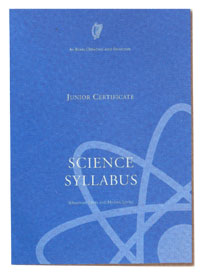| 2003 |

|
YEAR BOOK |
Departement of Education and Science
|
Revised Junior Certificate Science Syllabus introduced
|

|
� The revised syllabus has a greatly increased emphasis on scientific investigation and on hands-on student practical work.
� To allow sufficient time for the more practical approach, the overall length of the syllabus has been significantly reduced. � The structure of the syllabus has been simplified. � The assessment of the revised syllabus includes, for the first time, a significant element of coursework in addition to a terminal examination paper. |
The syllabus was first published on the Web in May and was subsequently distributed to schools in hard copy. The revision of this syllabus was one of the recommendations of the Task Force on the Physical Sciences. (The Report of the Task Force was described in The Irish Scientist 2002 Year Book, pages 16-17 .)
Structure of Syllabus
The old syllabus had a core and five extensions. All students studied the core and had a choice between the extensions, the extent of the choice depending on whether the student was following the Higher level or the Ordinary level course. By contrast, the revised syllabus has just three main sections - biology, chemistry and physics - each of which is set out in three sub-sections. All students must study material from all sections, although within each section there is content that is designated as being for those following the Higher level course only.
Assessment
The introduction of coursework is a major change in how the syllabus is to be assessed. The examination paper is allocated 65% of the total examination marks, and there are two components in the coursework assessment, Coursework A and Coursework B, which are allocated 10% and 25% of the marks, respectively. Coursework A involves the carrying out and recording of thirty mandatory student activities which are identified in the syllabus. In Coursework B, candidates are required to submit a report of either two separate investigations selected from three nominated each year by the State Examinations Commission or of a single investigation of the student's own choosing, which meets set criteria.
Resources
In response to concerns about the availability of laboratory resources in some schools, the syllabus has been introduced initially on an optional basis. Schools opting for the revised syllabus have been invited to apply for equipment grants to meet their perceived needs. All schools in the Free Education Scheme opting for the revised syllabus can apply for grants of �3,500 for each Junior Science laboratory; less well-equipped schools can apply for enhanced grants. In addition to equipment needs, it is recognised that some schools have inadequate laboratory space. It is estimated that the cost of resourcing all schools to provide the revised syllabus will be in the region of �12M in addition to the grants already provided to support the teaching of the sciences.
���An in-career development programme for teachers to support the introduction of the revised syllabus has been put in place. The programme is being delivered by a team consisting of a National Co-ordinator and nine Regional Development Officers based in Sligo Education Centre. The primary focus of the programme is the development of appropriate methodologies to address the emphasis on the investigative approach to learning and on science process skills contained in the revised syllabus. While subject content is not seen as a major issue, the programme includes provision for addressing identified needs in this area. In addition to delivering the in-career development programme, the support team also provides advice to principals and school staff. A helpline service is also available.
Chief Examiners' Reports
Each year the Chief Examiners' reports are published for a number of subjects. Last year saw the publication of reports on the 2001 examinations in four of the sciences: Leaving Certificate Biology, Agricultural Science and Physics & Chemistry, and Junior Certificate Science. This year the Chief Examiners' reports on the 2002 examinations in three of the sciences were published. These were Leaving Certificate Chemistry, Physics and Biology. These reports give an overview of the grades obtained, an analysis of the answering of the paper and recommendations for teachers and students.
The Chemistry and Physics reports are of particular interest since 2002 was the first examination of the revised syllabi in these subjects. The reports show a small, but significant, increase in participation rates in both subjects; of the total Leaving Certificate cohort in 2002, 11.7% took Chemistry and 15.6% took Physics. In 2000, when participation rates in both subjects reached a minimum, the corresponding figures were 11.0% and 14.1%. While the 2002 figures are still well short of the participation rates of 20-21% which obtained in the mid-'eighties, there is reason for optimism that the downward trend in participation rates may have been reversed. The revised Junior Certificate syllabus, with its fresh approach to teaching and learning, should help to consolidate the new upward trend.
Copies of the Chief Examiners' reports are available on the Department's website, www.education.ie .
Contact: Dr Carl � D�laigh,
Deputy Chief Inspector,
Department of Education and Science, Marlborough Street, Dublin 1.